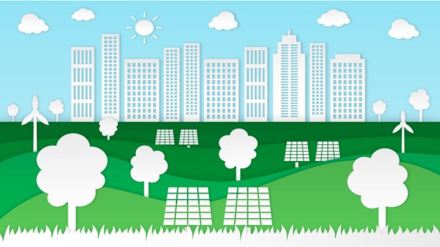The World Environment Day 2024 is being celebrated today and with this the spotlight has turned on how various industries are adapting to meet environmental challenges. One sector undergoing significant transformation is real estate, where sustainability is increasingly becoming a core focus. Architects and developers are embedding eco-friendly practices into their designs, ensuring that new buildings are both environmentally responsible and economically viable.
The Growing Trend of Sustainable Real Estate
The shift towards sustainability in real estate is driven by the urgent need to address climate change, resource depletion, and the overall environmental impact of construction. Sustainable building practices include the use of energy-efficient systems, water conservation technologies, and eco-friendly materials. These practices not only help reduce the carbon footprint of buildings but also enhance their long-term viability and appeal to environmental conscious investors and customers.
Sustainability Practices in Real Estate
Real estate developers are increasingly pursuing green building certifications, such as those provided by the Indian Green Building Council (IGBC), which range from Silverto Platinum levels. These certifications serve as benchmarks for sustainability and signify that a building meets rigorous environmental standards. Energy efficiency is a key focus, involving advanced systems designed to reduce energy consumption, such as high-performance HVAC (heating, ventilation, and air conditioning) systems and LED lighting. Water conservation measures are also becoming standard, including dual plumbing systems that reuse water for non-potable purposes and low-flow fixtures that reduce water usage without compromising performance.
Additionally, the use of sustainable materials that have minimal environmental impact is gaining traction. Developers are also prioritizing community engagement and social sustainability by incorporating amenities like community gardens, bicycle lanes, and electric vehicle charging stations into their projects. These features not only improve the quality of life for residents but also foster a culture of environmental stewardship.
Also Read: How to make the most of pre-approved home loan offers
Challenges and Opportunities
While the shift towards sustainability presents numerous benefits, it also comes with challenges. The initial costs of implementing green technologies can be high, which may deter some developers. However, the long-term benefits, including lower operational costs and higher property values, often outweigh these initial expenses. Moreover, as regulatory pressure increases and environmental awareness grows, the demand for sustainable buildings is expected to rise.
The Role of Technology
Technology plays a crucial role in advancing sustainable real estate. Innovations in building materials, energy systems, and water management are making it easier for developers to meet sustainability standards. Smart building technologies, which optimize energy use and enhance indoor air quality, are also becoming more prevalent, contributing to healthier and more efficient living environments.
Commenting on the same, Amar Sarin, MD & CEO, TARC Limited, said, “At TARC, sustainability is embedded in our DNA. For instance, one of our projects, TARC Tripundra, incorporates advanced energy-efficient systems and solar panels, and TARC Kailasa, striving for IGBC Platinum certification, integrates over 100 sustainability parameters. We believe that real estate development should not only meet the needs of today but also ensure a better future for generations to come.”
“On this World Environment Day, it is vital to understand how India’s real estate market is changing with a strong emphasis on sustainability. With buildings accounting for nearly 40% of Green House Gas emissions in India, it is imperative to shift towards eco-friendly construction. Aware of the challenge, materials like fly ash bricks, bamboo, and repurposed steel are gaining momentum in the industry. These materials not only minimize the overall carbon footprint of new developments, but they are also environmentally sustainable. When combined with water-saving fixtures and energy-efficient designs, they add up to a substantial contribution to the development of green buildings. Additionally, consumer trends show that there is a strong desire for eco-friendly living spaces with many consumers willing to pay a premium for environmentally-friendly products. By harnessing the potential of recycling, the real estate industry not only mitigates environmental impact, but also unlocks innovative avenues for growth and development,” said Amrita Gupta, Director of Manglam Group, and Founder President of CREDAI Rajasthan Women’s Wing.
As the real estate sector continues to evolve, the focus on sustainability is becoming more pronounced. Developers are increasingly recognizing the importance of building environmentally responsible and resilient structures. By integrating sustainable practices, the real estate industry can play a significant role in addressing global environmental challenges and promoting a greener future.
